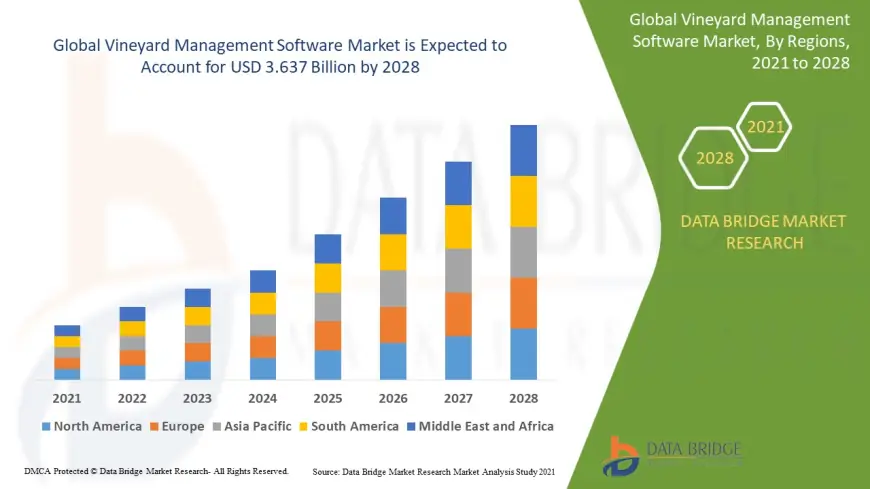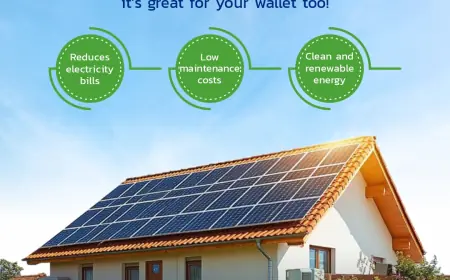Vineyard Management Software Market Industry Statistics: Growth, Share, Value, Insights, and Trends

1. Introduction
Vineyards play a crucial role in the wine industry, requiring precise management of crops, resources, and external factors such as weather conditions and pests. As the industry grows, technology has stepped in to provide solutions for better productivity and sustainability. One such innovation is vineyard management software, which helps vineyard owners streamline operations, optimize yields, and ensure quality control.
The vineyard management software market is expanding rapidly, driven by increasing adoption of smart farming technologies and the demand for data-driven decision-making. This article explores the market, key trends, benefits, and future outlook of vineyard management software.
2. Understanding Vineyard Management Software
What is Vineyard Management Software?
Vineyard management software is a specialized digital solution designed to help vineyard owners and managers oversee all aspects of their operations. From monitoring crop health to managing labor, inventory, and finances, this software provides a centralized platform for managing vineyard activities.
Key Functions and Features of the Software
The best vineyard management software solutions typically offer the following features:
-
Crop and field management: Tracks vine growth stages, soil conditions, and irrigation needs.
-
Weather monitoring: Integrates real-time weather data and forecasts to optimize farming decisions.
-
Pest and disease control: Helps identify risks and implement preventive measures.
-
Inventory management: Manages stocks of fertilizers, pesticides, and other vineyard essentials.
-
Financial tracking: Keeps records of expenses, revenue, and overall profitability.
With these capabilities, vineyard management software allows wineries to improve efficiency, reduce costs, and increase yield quality.
3. Market Overview and Growth Trends
Market Size and Expected Growth (2024-2030)
The global vineyard management software market is witnessing steady growth, with an expected CAGR of over 10% from 2024 to 2030. This growth is fueled by the increasing demand for precision agriculture, automation, and digital transformation in viticulture.
Factors Driving the Growth of Vineyard Management Software
Several factors are contributing to the rising adoption of vineyard management software:
-
Growing Demand for Wine – Expanding wine production worldwide is driving the need for better vineyard management.
-
Technology Adoption in Agriculture – The rise of smart farming and IoT applications in agriculture is fueling market growth.
-
Regulatory Compliance – Governments and industry bodies are implementing stricter regulations on vineyard operations, requiring better tracking and management solutions.
Challenges and Limitations
Despite its advantages, the vineyard management software market faces challenges such as:
-
High Initial Investment Costs – Small vineyards may struggle with the cost of software implementation.
-
Technical Complexity – Many vineyard managers are not tech-savvy, leading to resistance in adopting new technology.
-
Limited Awareness – Some vineyard owners are unaware of the benefits and availability of such software solutions.
4. Key Features of Vineyard Management Software
Vineyard management software provides various tools to help streamline daily operations. Some of the key features include:
1. Crop and Field Management
-
Tracks vineyard growth cycles and environmental conditions
-
Provides real-time insights for efficient resource allocation
2. Weather Monitoring and Forecasting
-
Integrates with meteorological data sources for real-time weather updates
-
Alerts vineyard managers about extreme weather conditions
3. Pest and Disease Management
-
Uses AI and machine learning to predict pest outbreaks
-
Recommends pest control measures to prevent crop loss
4. Inventory and Resource Tracking
-
Tracks fertilizers, pesticides, and equipment usage
-
Helps maintain optimal inventory levels to avoid shortages or excess stock
5. Financial and Business Analytics
-
Provides insights into operational costs and revenue generation
-
Helps vineyard owners make data-driven financial decisions
5. Benefits of Vineyard Management Software
Implementing vineyard management software offers multiple benefits to vineyard owners and wine producers:
1. Increased Productivity and Efficiency
-
Automates various manual tasks, reducing human errors
-
Enhances overall vineyard productivity
2. Cost Reduction and Waste Minimization
-
Optimizes the use of water, fertilizers, and pesticides
-
Reduces unnecessary expenses, improving profitability
3. Data-Driven Decision-Making
-
Uses analytics and AI-powered insights to guide farming decisions
-
Helps vineyard managers make informed choices regarding crop management
4. Compliance with Industry Regulations
-
Ensures adherence to local and international viticulture standards
-
Provides audit trails and traceability for wine production
6. Market Segmentation
The vineyard management software market can be segmented based on deployment type, application, and region.
1. By Deployment Type
Vineyard management software can be either:
-
Cloud-based: Hosted on remote servers and accessible via the internet. Ideal for large-scale vineyards needing real-time data sharing.
-
On-premises: Installed locally on a vineyard’s infrastructure. Preferred by vineyards with limited internet connectivity or strict data security policies.
2. By Application
-
Small Vineyards: Typically family-owned businesses or small-scale wine producers with limited acres under cultivation. These vineyards often require basic management features.
-
Large-scale Wineries: Industrial-level vineyards needing advanced features like AI-driven forecasting, automated irrigation systems, and large inventory tracking.
3. By Region
-
North America: Leading market due to high technology adoption and significant wine production in California.
-
Europe: Strong growth in countries like France, Italy, and Spain, where wine production is a key industry.
-
Asia-Pacific: Emerging market with increasing interest in viticulture in countries like China and Australia.
-
Latin America & Africa: Slow adoption but promising future due to expanding wine markets.
7. Leading Companies in the Vineyard Management Software Market
Several companies dominate the vineyard management software market, offering innovative solutions to optimize vineyard operations. Some of the top players include:
1. VineSpring
-
Specializes in direct-to-consumer (DTC) winery sales solutions
-
Offers CRM tools for customer relationship management
2. Vintrace
-
Cloud-based vineyard and winery software
-
Features include inventory tracking, compliance reporting, and financial analysis
3. AgriTask
-
AI-powered vineyard management software
-
Helps with pest management, weather monitoring, and resource allocation
4. eVineyard
-
Affordable software tailored for small and medium-sized vineyards
-
Focuses on automating labor tasks and tracking vineyard performance
5. Croptracker
-
Provides harvest tracking and traceability solutions
-
Integrated with GPS mapping and analytics tools
These companies compete by offering user-friendly interfaces, AI-powered analytics, and scalable pricing models to meet the needs of both small and large vineyards.
8. Regional Insights and Market Trends
1. North America
-
The U.S. dominates the market, particularly in California’s Napa Valley and Sonoma County.
-
High adoption of smart farming technologies, AI, and IoT sensors.
2. Europe
-
France, Italy, and Spain lead in vineyard software adoption due to strict wine production regulations.
-
The EU’s Common Agricultural Policy (CAP) promotes digital transformation in viticulture.
3. Asia-Pacific
-
Australia and China are rapidly adopting precision agriculture to enhance wine production.
-
Government support for digital farming initiatives is boosting market growth.
4. Latin America & Africa
-
Argentina, Chile, and South Africa are emerging markets for vineyard software.
-
Growing investment in agriculture technology (AgTech) is driving adoption.
9. Challenges in the Vineyard Management Software Market
Despite its advantages, vineyard management software faces some hurdles:
1. High Initial Investment Costs
-
Advanced software with AI-driven insights can be expensive, making it inaccessible to small-scale vineyard owners.
2. Technical Difficulties and Integration Issues
-
Many traditional vineyard owners lack technical expertise, making software adoption difficult.
-
Compatibility issues with existing vineyard equipment can delay implementation.
3. Resistance to Technology Adoption
-
Many vineyard managers prefer traditional farming methods over digital solutions.
-
Training and onboarding costs add to the reluctance of vineyard owners.
To overcome these challenges, software providers must offer affordable pricing, user-friendly interfaces, and strong customer support.
10. Future Outlook and Opportunities
The future of vineyard management software looks promising, with several advancements on the horizon:
1. Role of AI and Automation in Vineyard Management
-
AI-driven analytics will predict grape yields and optimize irrigation schedules.
-
Machine learning algorithms will detect early signs of disease and pest infestations.
2. Emerging Trends in Precision Viticulture
-
IoT sensors, drones, and satellite imagery will provide real-time data on vineyard conditions.
-
Blockchain technology will ensure wine traceability from vineyard to bottle.
3. Expected Advancements in Software Capabilities
-
Increased integration with mobile apps for on-the-go vineyard management.
-
Augmented reality (AR) tools for visualizing vineyard health and soil conditions.
These innovations will improve efficiency, sustainability, and profitability for vineyard owners.
11. How to Choose the Right Vineyard Management Software
Selecting the right vineyard management software depends on several factors:
1. Key Factors to Consider
-
Features & Functionality: Does the software include crop tracking, inventory management, and weather forecasting?
-
Ease of Use: Is the interface user-friendly for vineyard workers?
-
Integration: Does it connect with existing farming equipment and sensors?
-
Cost & Scalability: Is the pricing affordable? Can the software grow with the business?
2. Comparing Pricing, Features, and User Experience
-
Free trials and demos allow vineyard owners to test software before purchase.
-
Online reviews and case studies provide insights into real-world user experiences.
12. Case Studies of Successful Implementation
Case Study 1: A Family-Owned Vineyard in California
-
A small vineyard adopted AI-driven software to track irrigation and reduce water waste.
-
Outcome: 25% reduction in water usage and improved grape quality.
Case Study 2: Large Winery in France
-
A large-scale winery implemented cloud-based vineyard management software for inventory tracking.
-
Outcome: 20% increase in production efficiency and streamlined compliance reporting.
These success stories showcase how vineyard software improves productivity and sustainability.
13. Integration with Other Smart Farming Technologies
Vineyard management software is increasingly integrated with other smart farming technologies:
1. IoT, Drones, and Smart Sensors
-
IoT sensors collect data on soil moisture, temperature, and plant health.
-
Drones provide aerial images of vineyards to detect problem areas.
2. The Role of Blockchain in Wine Traceability
-
Blockchain ensures transparent wine production records from grape harvest to bottling.
-
Consumers can scan QR codes to verify the authenticity and origin of the wine.
14. Conclusion
The vineyard management software market is transforming the wine industry by offering digital solutions to optimize vineyard operations. With features like crop monitoring, pest control, inventory tracking, and financial analytics, this software enhances productivity and profitability.
Despite challenges like high costs and resistance to technology, ongoing advancements in AI, IoT, and blockchain are driving market growth. As precision viticulture continues to evolve, adopting vineyard management software will become a necessity for wineries aiming to stay competitive.
Get More Links : https://www.databridgemarketresearch.com/reports/global-vineyard-management-software-market
https://www.databridgemarketresearch.com/reports/global-automotive-transfer-case-market
https://www.databridgemarketresearch.com/reports/north-america-travel-beauty-retail-market
https://www.databridgemarketresearch.com/reports/global-mycoses-treatment-market
https://www.databridgemarketresearch.com/reports/global-polyester-based-flexible-heater-market
https://www.databridgemarketresearch.com/reports/global-cast-polypropylene-films-market
15. FAQs
1. What is vineyard management software used for?
Vineyard management software is used to track crop health, manage resources, optimize irrigation, and improve vineyard efficiency.
2. How much does vineyard management software cost?
Prices vary depending on features and deployment type. Basic plans start at $50/month, while advanced AI-driven software can cost thousands per year.
3. What are the top vineyard management software solutions?
Popular options include Vintrace, eVineyard, Croptracker, and AgriTask.
4. How does AI impact vineyard management?
AI helps predict grape yields, detect diseases early, and automate vineyard operations, reducing labor costs.
5. What challenges do vineyards face when adopting this software?
High costs, lack of technical skills, and integration issues are common adoption challenges.
What's Your Reaction?
 Like
0
Like
0
 Dislike
0
Dislike
0
 Love
0
Love
0
 Funny
0
Funny
0
 Angry
0
Angry
0
 Sad
0
Sad
0
 Wow
0
Wow
0

















































